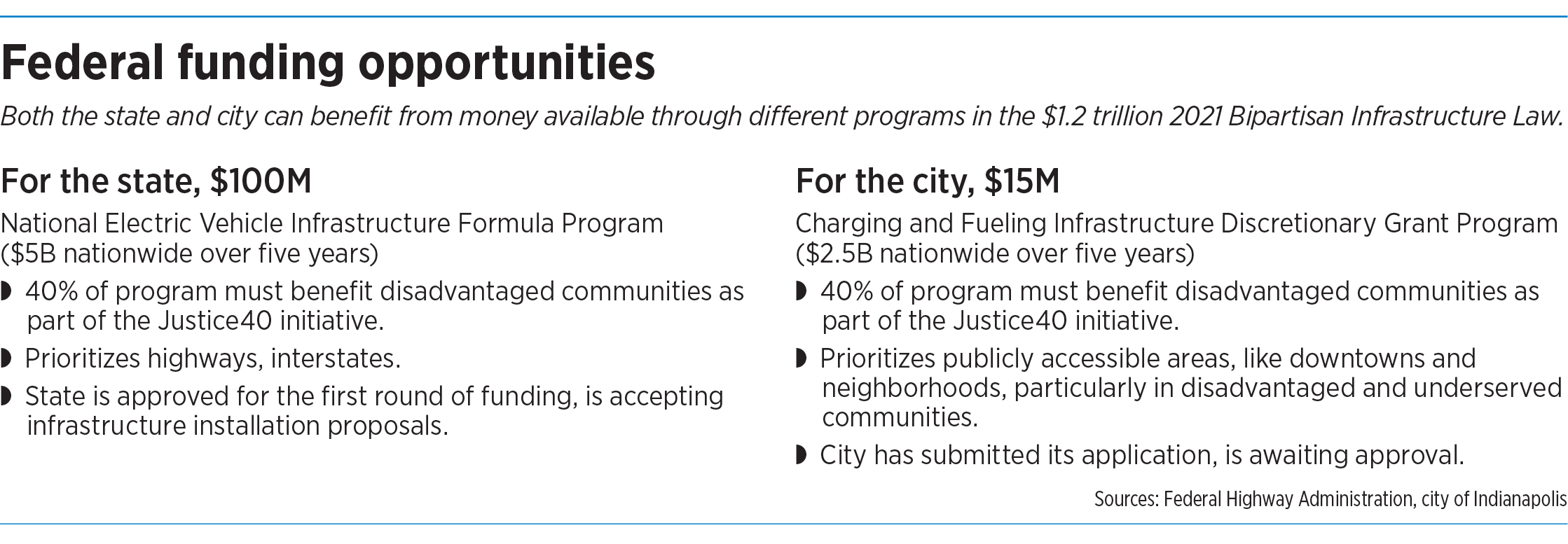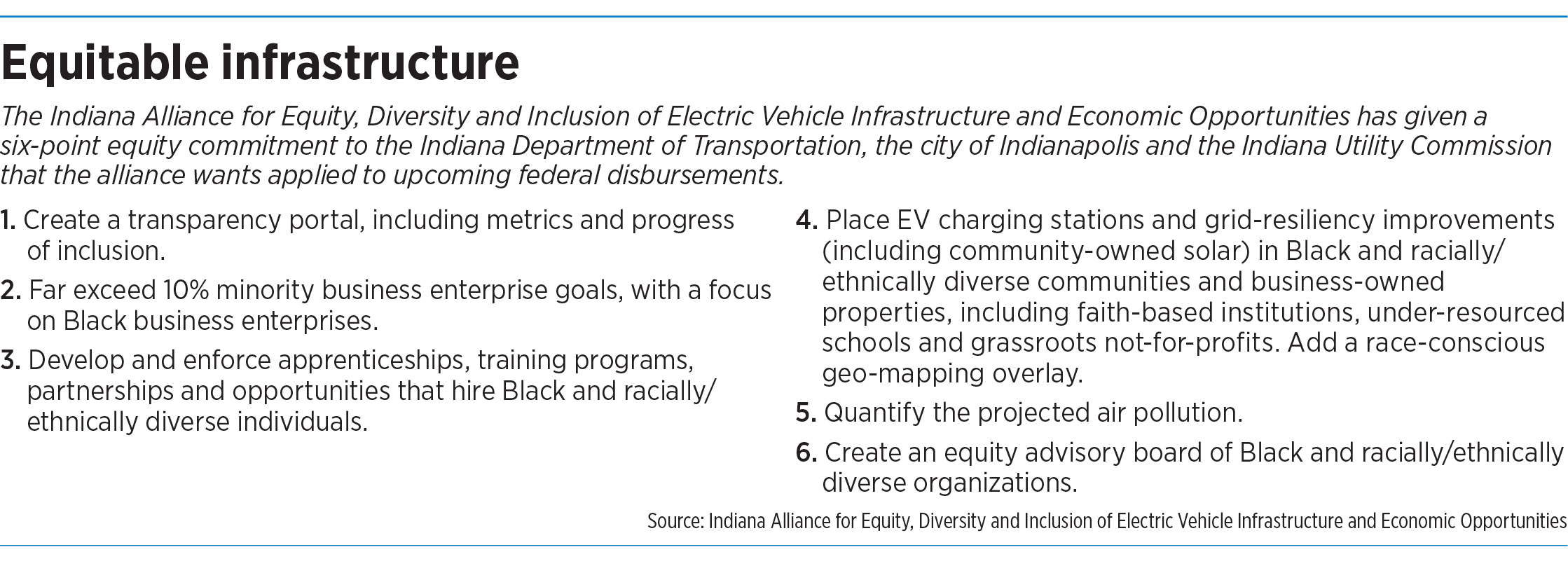Subscriber Benefit
As a subscriber you can listen to articles at work, in the car, or while you work out. Subscribe NowA group of Black civil rights organizations is amping up its call for racial equity to be taken into account as state and city leaders decide where to place chargers needed to support the growing number of electric vehicles.
The push comes as Indiana government officials decide how to spend at least $100 million in federal funding on the state’s EV infrastructure, the Indiana Utility Regulatory Commission creates new EV policies, and the city of Indianapolis seeks a $15 million federal grant to install its own charging stations.
The Indiana Alliance for Equity, Diversity and Inclusion of Electric Vehicle Infrastructure and Economic Opportunities—a coalition of 25 organizations—formed in early 2022 to help ensure that federal funds were used by the state in an equitable manner and that EV chargers are placed in underserved communities.
Group members were unhappy with what they considered a lack of engagement with the Black community on Indiana’s federally funded charger placements. The state says the process is ongoing, with six public meetings in July held in or near underserved communities and plans to create equity goals and engage minority-owned businesses.
Now the alliance believes it has another chance to influence the process by participating in a utility review and policy-creation process for EVs held by the Indiana Utility Regulatory Commission. The IURC will set EV policies to be followed by AES Indiana, CenterPoint, Duke Energy, Indiana Michigan Power Co. and Northern Indiana Public Service Co.
The IURC will issue a final order in about three months. Stephanie Hodgin, executive director of strategic communications for the IURC, said the order will then be voted on at a yet-to-be-scheduled public meeting.
The alliance is urging the IURC “to make sure that all utilities will promote affordable and equitable electric vehicle charging options for residents [and for] commercial and public electric vehicle charging infrastructure; improve the experience and association with electric vehicle charging; and accelerate third-party investment in electric vehicle chargers,” said state Rep. Carolyn Jackson, a Hammond Democrat and member of the equity alliance.
Douglas Everette, an attorney with Dentons Bingham Greenebaum LLP representing the alliance, said the commission can look to other U.S. cities for examples of how to motivate electric utilities to prioritize disadvantaged communities. One such example is Portland Electric in Oregon, which has a program that provides subsidies for charger placement.
Denise Abdul-Rahman, the environmental climate justice chair for the Indiana NAACP, said the equity alliance was unhappy with the state’s previous efforts to develop a plan for federal grant money because early events were hosted in nearly all-white municipalities during working hours, and because a survey of 2,000 people did not keep data on race and ethnicity of those surveyed.
Ultimately, the state’s grant plan was approved by the federal government over the coalition’s objections. Bid awards for charger installation will be announced early next year, with the first stations expected to be operational by early 2025, Indiana Department of Transportation spokeswoman Natalie Garrett wrote in an email to IBJ.
Garrett said INDOT will create an equity engagement plan for the remainder of the five-year grant program. Equity considerations also will be taken into account when installers for the charger system are selected. The agency has hosted networking events in Indianapolis, Evansville, Fort Wayne and Gary to connect minority-owned contractors to bidders.
The city of Indianapolis has applied for a $15 million federal grant to install its own electric charging stations. The U.S. Department of Transportation has said it will award the first round of funding from the Charging and Fueling Infrastructure Discretionary Grant Program this fall.
Indianapolis has nearly 2,700 registered electric vehicles, with the Office of Sustainability aiming for 3,040 by 2025. Nationally, the number of EVs on the road is expected to grow to 26.4 million by 2030.
Community grants from the charging and fueling infrastructure program provide chargers to urban and rural communities in publicly accessible locations. Those locations include both downtown areas and other neighborhoods, particularly in underserved and disadvantaged communities, according to the Transportation Department.
About $1.25 billion in such grants will be awarded nationwide over five years (with another $1.25 billion distributed to what the Transportation Department calls “alternative fuel corridors”). Indianapolis is seeking the maximum community award of $15 million and would be required to match 20% of that, according to the Transportation Department.
Office of Sustainability Senior Project Manager Mo McReynolds said the city’s application includes an emphasis on economic feasibility, community engagement and workforce development. But the federal grant limits the amount that can be spent on community engagement and education to 5% of the total award, or about $750,000 if the city receives the full $15 million, McReynolds said.
Much of the criticism of the state’s federal grant expenditures has centered on a perceived lack of engagement with Black communities. City officials, in partnership with the alliance, said they hope for thorough community engagement despite the restrictions of the grant they’re applying for.
“We’re a little disappointed about that regulation, but we’ll do what we can with the budget if we are allotted any,” McReynolds said.
If the city receives the grant, staff will first conduct a feasibility study, she said. Taking into account chargers funded by grants the state receives and by other sources, the Office of Sustainability will decide where gaps remain.
The city of Indianapolis made an early foray into electric vehicles with BlueIndy rental cars. The $6 million project launched in September 2015 and was shuttered in May 2020. The city issued a request for information the following month for suggestions on what to do with the nearly 90 BlueIndy charging stations with underground power. In August 2022, the city issued an RFP on the same topic that closed later that month. Officials have not yet announced next steps for the program.
These spots could be used for electric vehicle charging stations, for e-scooter and e-bike charging, for rideshare services, or for placemaking efforts like food trucks.
Abdul-Rahman of the NAACP said she is hopeful the Federal Highway Administration will fund Indianapolis and other Indiana communities, to “give us some assurance that equity will bend in our direction.”
For Abdul-Rahman, that means ensuring that Black contractors are trained to install the chargers, that Black businesses are awarded some of the work and that charging stations are installed near Black churches and businesses.
Letters of support from Democratic U.S. Rep. Andre Carson to the FHWA give the alliance hope the grant will be approved, Abdul-Rahman said. Carson serves on the House Transportation and Infrastructure Committee.•
Please enable JavaScript to view this content.





They should turn a lot of the blue indie spots into electric vehicle charging stations. And maybe they should look at zip codes for the largest number of electric vehicles are registered and make sure there are some charging stations in those areas
Rhea P.
+ 1
Yes, put the charging stations in the neighborhoods where they will be used.
EV’s are expensive. Many neighborhoods around the city will have very few if any
for at least two decades.
Here’s an idea. Let the investors that are the experts in EV Charging stations
pick the locations. It’s rediculious that we always have to cowtow to the social
justice warriors that have NO SKIN in the game.
There is a prominent country club in Indiana that installed 3 electric vehicles charging stations 2 years ago. I guess it was assumed members where wealthy, and could and would, be buying electric vehicles. They were removed for lack of usage. The moral of this story is that the public is a long way from accepting a totally electric vehicle society despite what political leaders are pushing. There will be a long period of transition most likely hybrid cars will play a more prominent position for several decades in the interim. And yes, I am a proponent of EV’s!
I have no problem with the people that want EV’s. Have at it.
But the government should not be interfering in the market. We didn’t need the
government to take us from the horse & buggy to the Model T.
Why have a DEI component for EV charging stations?..its all about getting a slice of the pile of money